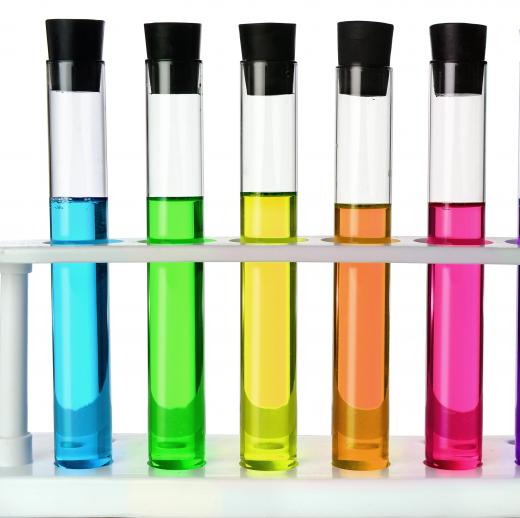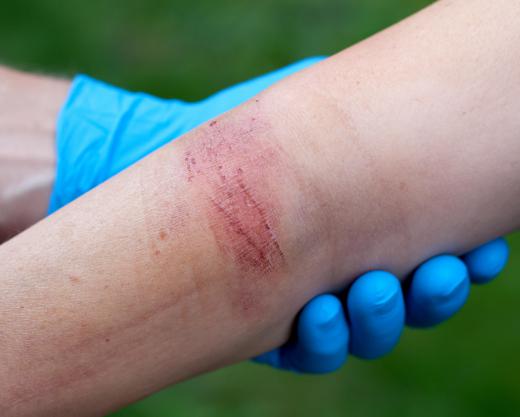What is Silver Nitrate?
Silver nitrate is a soluble compound with the chemical symbol AgNO3 that is used as a reagent in scientific experiments, a topical treatment for things like warts and bacterial infections, and a general antibacterial for use in medicine and industry. It is popular is pharmaceuticals but is generally only approved for external use, and even then typically only in very diluted preparations. The compound is quite effective, but is also very dangerous when ingested and can burn the skin terribly if improperly prepared.
Isolating It

Chemists make silver nitrate by dissolving pure silver in liquid nitric acid. When the metal hits the acid it crystallizes pretty quickly and forms salts. This reaction is fast but it tends to emit a lot of fumes, and as a result it is usually only done in labs or other facilities with good ventilation. The salts are usually dried and then either stored on their own or diluted, as is often the case with medical and pharmaceutical preparations.
Identifying Other Compounds

One of the most important jobs of the compound in chemistry is as a “reagent,” which means that it can help identify and isolate other chemicals and elements based on how it interacts with them. Materials are typically treated with a special solution to separate or deactivate other ions that are present, then drops of liquid AgNO3 are added. If a specific compound is present, the material will change colors: white indicates the presence of chloride, for instance, cream indicates bromide, and yellow typically means iodine.
Medical Uses

In medicine, the compound is commonly used either as a highly diluted liquid or as a soft stick, sometimes called a “pencil.” As a liquid or spray it can help remove bacteria from the eyes or other mucus membranes. Hospitals sometimes use it as an eye drop for newborns to prevent blindness or infection from a mother's gonorrhea, though in many places this practice has been phased out in favor of other drugs and drops with fewer side effects. The nitrate drastically lowered the incidence of blindness thanks to its antibacterial properties, but incorrect dosage sometimes led to serious burns which in many cases actually caused blindness or other vision problems.

Caustic pencils are frequently used to heal oral ulcers or as a way of cauterizing, or removing the dead tissue from, stomas and surgical openings. Podiatrists may also use it on occasion to kill bacteria and other harmful cells within the nail bed of the toes, and it can be used to kill warts on contact, too.
Silver nitrate is also used in some places as an alternative to antibiotics. This practice is somewhat controversial, though, and is not approved by many government regulatory bodies including the United States’ Food and Drug Administration. Most of the time this is because of the risks when the compound isn’t mixed or dosed properly. It’s not generally dangerous when heavily diluted and used sparingly, though it can be extremely dangerous when consumed or used at very high levels.
Antibacterial Properties

One of the most beneficial things about the compound is its ability to kill germs. These antibacterial properties make it popular in water purification and decontamination, particularly in places where clean water isn’t readily available like in the wilderness, on space shuttles, or in the developing world. It has also been used to disinfect and clean vegetables and fruits, and can be used to sterilize and scrub animal pens and barns. Some household cleaning products like laundry detergent include it as an ingredient, too. When used for these purposes, it is important that the substance is heavily diluted and used only as directed.
Risks and Dangers

Ingesting silver nitrate can be fatal for both humans and animals, and in most cases it should only touch the skin in very low concentrations for limited amounts of time. Most poison control authorities consider it a toxin. It is also highly corrosive, which means that it can eat though many materials including metal. People who touch it in raw or high concentrations can also experience severe burns or skin lacerations. Trace amounts of it can be beneficial, but in the wrong proportions it can cause serious problems.
AS FEATURED ON:
AS FEATURED ON:
















Discussion Comments
FDA! The FDA! Why is it, if something works, the FDA sticks their noses into "it", and the substance ceases to "work"? If they knew who I was, they'd come at me, with guns drawn, and badges "showing", I suppose! It is a substance which kills all bacteria, and all viruses!
Post your comments